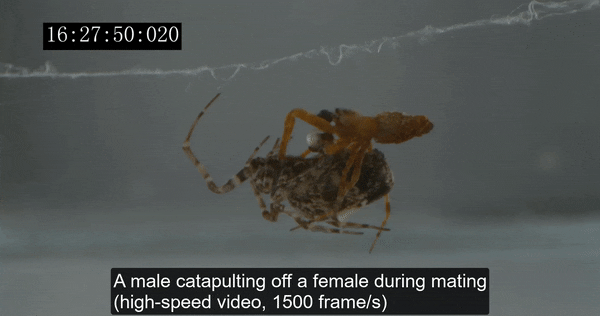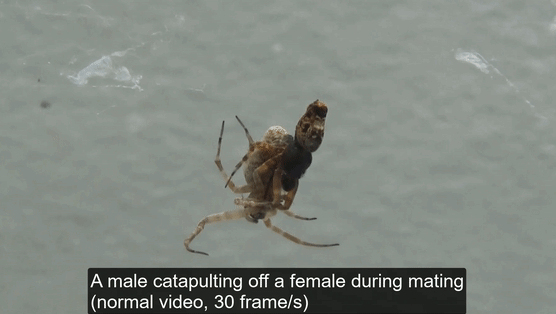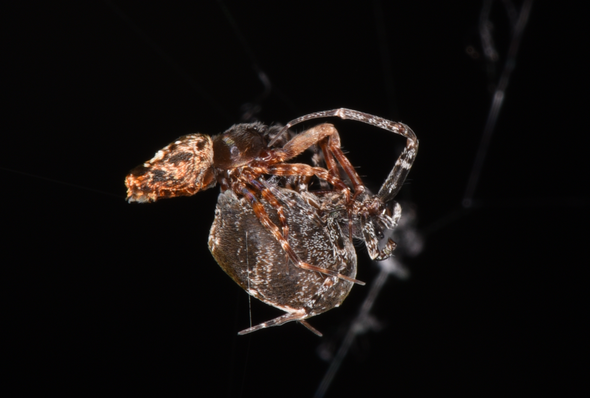For some male spiders, love is all-consuming. In a grisly practice known as sexual cannibalism, females of many spider species devour their mates after procreation, either for sustenance or to keep their reproductive options open.
Female spiders are usually much larger than their male counterparts and thus have a strong physical advantage. But new research published on Monday in Current Biology shows that a number of seemingly overmatched males are not completely helpless. Thanks to energy stored in their front leg joints, the males of a species of orb-weaving spiders called Philoponella prominens can catapult themselves off of a ravenous mate in a split second. “When I first observed this catapulting behavior in the field, I knew I had found something special, based on my 13 years of studying the sexual behaviors of spiders,” says the study’s lead author Shichang Zhang, a behavioral ecologist at China’s Hubei University.
These orb-weaving spiders live together in condominiumlike complexes that are formed from many interconnected webs and can house more than 200 individuals. With so many leggy bachelors roaming around, females can afford to devour a few—so to avoid becoming a postcoital snack, male spiders must flee immediately after procreation. The researchers discovered that during the deed itself, male spiders fold their front legs against the female. Immediately after mating, they straighten their legs, utilizing the hydraulic pressure built up along their tibia-metatarsus joints to launch themselves like a spring.

The spiders fling themselves off their mates so fast that ordinary cameras cannot capture the behavior. So the researchers used a Beijing advertising agency’s special high-speed camera to film the mating spiders. Breaking down the dramatic escapes at 1,500 frames per second, the scientists calculated just how fast these males were moving. The spiders, which on average were only about three millimeters long, launched themselves at speeds approaching 88 centimeters per second. “Imagine a man with a height of 1.8 meters catapulting himself 530 meters in one second,” Zhang says. “That’s what these male spiders do.” As the acrobatic arachnids soar, they also spin like an eight-legged top, rotating nearly 175 times per second on average.
Among the 155 pairs of orb-weaving spiders initially recorded, 152 males successfully catapulted. All of the jumpers survived the sexual encounter, but the three that failed to make the leap were promptly eaten.

To confirm whether a male spider’s leaping prowess really was a matter of life or death, the researchers used a fine brush to stick several male spiders to their mates, restricting their ability to catapult. All of these spiders were consumed.
Surprisingly, the escaped males actually do return to their cannibalistic mates. During mating, they fasten a silk “safety line” to their partner. And after they catapult, they crawl back along this line to mate with her again. They can repeat this cycle up to six times.
Continually coming back to a homicidal partner may seem reckless, but the male spiders are wired to ensure they inseminate a female spider with their genetic information. As long as they can catapult to safety, they try to mate again and again.
Though sexual cannibalism seems gruesome from a human perspective, the behavior makes evolutionary sense, according to Matthias Foellmer, a biologist who studies spider sexual cannibalism at Adelphi University. In most spider species, males contribute nothing to the next generation beyond their sperm. “From a female perspective, why wouldn’t she eat him?” says Foellmer, who was not involved with the new study. “If you think about it that way, it’s surprising it’s actually not more prominent.”
The researchers on the new study posit that the male orb weavers’ spectacular escapes may benefit females, in terms of genetic choices, by helping determine the fitness of different males. Whereas male spiders who cannot catapult are essentially gobbled out of the gene pool, males that can launch themselves may be more enticing to a female when they return to mate again.
Foellmer says this study illustrates how cannibalism can spark an evolutionary arms race between the sexes. Because of the high escape rate the researchers recorded, it appears that catapulting has tipped the scales toward the males. “The males definitely have the upper hand in the arms race right now because they avoid being cannibalized,” he says. But the battle of the spider sexes is far from over. “There could,” Foellmer adds, “be a mutation arising that makes females a little quicker or better at grasping the males.”
A version of this article with the title “Spider Launch” was adapted for inclusion in the July 2022 issue of Scientific American.

